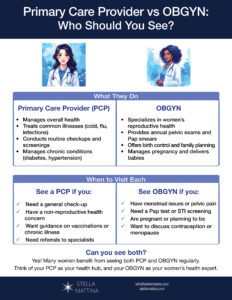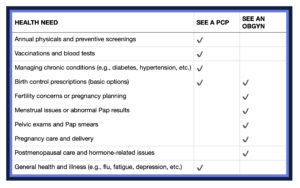
When it comes to managing your health, knowing which type of doctor to see can sometimes be confusing. You likely wonder how to choose between a primary care physician vs. ObGyn (a specialist in obstetrics and gynecology).
A primary care physician and an ObGyn focus on different aspects of caring for your health.
So – understanding the difference between these two types of physicians – primary care doctor and ObGyn – can help you make informed medical decisions. And with both on board, you’ll build a healthcare team that meets all your needs – from general checkups to specialized women’s health!
In this article, we’ll break down the roles of both primary care doctor/primary care physician and ObGyns – and highlight when to see each.
Table of contents:
What is a Primary Care Provider?
What’s the Difference Between an Internist and a Primary Care Physician?
What is an ObGyn?
What Happens at the First ObGyn Visit?
Internal Medicine vs. Gynecology: What’s the Difference?
ObGyn vs Primary Care Provider: Should I Have Both?
PCP vs ObGyn Checklist
 What is a Primary Care Provider?
What is a Primary Care Provider?
A Primary Care Provider (PCP) is a healthcare professional who serves as your first point of contact for most medical needs. They’re not ObGyns. Instead, they focus on your overall health. They’re trained to diagnose, treat, and manage a wide range of health concerns and long-term conditions.
Primary care doctors, including those in internal medicine and family medicine, complete medical school and then a residency in their area of focus.
This broad training allows primary care physicians to manage a wide range of health conditions in primary care clinics and coordinate your healthcare across specialties.
From everyday illnesses to chronic disease management, from infections and flu to annual physicals, a PCP helps keeps track of all your health issues and needs over time.
However, there are different types of primary care providers, including the following:
Family medicine doctors
Family doctors are trained to care for patients of all ages, from infants to seniors. After completing medical school, they undergo a family medicine residency. Here they receive broad training in pediatrics, adult medicine, geriatrics, and even some aspects of women’s health. This makes family physicians perfectly equipped to provide lifelong care for your whole family.
Internists
These specialize in adult medicine and complex health conditions.
Pediatricians
These are healthcare providers who focus on the health of children and adolescents.
Nurse practitioners (NPs) and physician assistants (PAs)
These are licensed clinicians who can provide primary care services for family medicine, often working alongside doctors.
In short, your primary care physician is your partner in long-term health. They help you stay well and navigate the healthcare system for you when issues arise. They play a vital role in:
Preventive care, including vaccines, health screenings, weight management, and lifestyle counseling.
Chronic disease management, such as high blood pressure, asthma, arthritis, or depression.
Initial diagnosis and treatment for common acute illnesses and symptoms, as well as guidance on when to see a specialist.
Basic women’s health screenings like Pap smears and breast exams.
Can a Primary Care Doctor Help with Pregnancy?
Yes. Many primary care providers (PCPs) can help with the early stages of pregnancy. They can confirm your pregnancy with a test, provide initial prenatal guidance, and discuss lifestyle changes like nutrition and supplements (such as folic acid). They also help address any early questions or concerns.
However, once your pregnancy is confirmed, you’ll typically be referred to obstetrics and gynecology for specialized prenatal care, monitoring, and delivery. That’s because ObGyns have the training and experience to manage all aspects of pregnancy, including potential complications, labor, and postpartum recovery.
Your primary care doctor may continue to support your general health during pregnancy, but the ObGyn takes the lead in managing the pregnancy itself.
In some cases, family doctors who offer obstetric care or a certified nurse midwife may also manage pregnancy and delivery, especially for low-risk pregnancies.
Your care path may vary depending on your health, your preferences, and what’s available in your area.
 What’s the Difference Between an Internist and a Primary Care Physician?
What’s the Difference Between an Internist and a Primary Care Physician?
Internal medicine doctors (also called internists) are a specific type of primary care doctor who focus exclusively on adult patients.
They have trained in the diagnosis and management of a wide range of adult health conditions, especially complex or chronic diseases such as high blood pressure and heart disease.
But internal medicine practitioners typically do not provide care for children or perform surgeries.
So, all internists are primary care physicians, but not all primary care providers are internists or family doctors.
Your choice depends on your age, health needs, and personal preference. If you’re an adult looking for a doctor to manage your overall health, an internal medicine doctor is a strong option.
Let’s move on to ObGyns…
 What is an ObGyn?
What is an ObGyn?
An ObGyn (short for obstetrician-gynecologist) is a medical doctor who specializes in women’s health, pregnancy, and childbirth. But is ObGyn primary care or specialist? Can an ObGyn be a PCP?
While some ObGyns may provide general wellness services, they’re specialists, not primary care doctors.
ObGyns attend medical school and then complete a four-year residency specifically in obstetrics and gynecology.
This specialized training prepares them to handle everything from routine reproductive care to complex surgical procedures and childbirth.
They’re trained to care for women through all stages of life, from the teenage years to menopause and beyond. They focus on diagnosing and treating conditions related to your reproductive system and are also experts in managing your pregnancy, labor, and delivery.
You might see an ObGyn for:
- Women’s health issues, such as irregular or painful periods
- Pelvic exams and Pap smears
- Contraception and birth control counseling
- Pregnancy care, including prenatal visits, ultrasounds, and delivery
- Menopause management, including hormone therapy
- Surgical procedures, such as hysterectomies, childbirth, or treatment for ovarian cysts, cervical cancer, fibroids, or other women’s diseases
As mentioned, while some ObGyns may offer routine screenings and exams, their primary focus is on reproductive health and related procedures. For broader health concerns, like managing high blood pressure or respiratory infections, you’ll still need to see a primary care doctor.
At what age should a woman start going to an ObGyn?
According to the American College of Obstetricians and Gynecologists (ACOG), girls should have their first obstetrics and gynecology visit between the ages of 13 and 15. This early visit is often more educational than medical and helps build a trusting relationship with the doctor.
 What Typically Happens at the First ObGyn Visit?
What Typically Happens at the First ObGyn Visit?
The first obstetrics and gynecology visit is usually focused on education, conversation, and building rapport. It typically includes a general health check, a discussion about periods, body changes, sexual health, and any concerns or questions you may have.
A pelvic exam or Pap smear is usually not required unless you’re experiencing symptoms or are over the age of 21, but your doctor may perform a basic physical exam.
This first contact is also a great opportunity to start developing a relationship with your ObGyn. You’ll then feel much more comfortable asking questions as your body and health needs change.
Can I Stop Seeing My ObGyn After Menopause?
You shouldn’t. It’s still important to see your ObGyn after menopause! While your reproductive years may be over, ObGyns continue to provide care for postmenopausal concerns. These include vaginal dryness (or other sexual health concern), hormone management, osteoporosis risk, and pelvic health. Regular exams also help detect conditions like ovarian or uterine cancer.
You now know the main differences between a primary care doctor and an ObGyn. Let’s have a quick look at internal medicine doctors and how they differ from gynecologists.
 Internal Medicine vs. Gynecology: What’s the Difference?
Internal Medicine vs. Gynecology: What’s the Difference?
Understanding the difference between internal medicine and gynecology is key when deciding which doctor to see.
While both internal medicine doctors and gynecologists care for adults, their areas of focus and training are very different.
Internal medicine doctors are trained to diagnose and manage a wide range of adult health issues, including chronic conditions like heart disease and thyroid disorders.
Obstetricianss and gynecologists, on the other hand, focus on diseases specific to the female reproductive system. For example, endometriosis, ovarian cysts, and cervical cancer.
Here is the main difference between both:
Internal medicine doctors specialize in adult general health, managing a wide range of non-surgical medical conditions such as high blood pressure, diabetes, thyroid disorders, and respiratory infections. They’re experts in preventive care, chronic disease management, and diagnosing complex health issues unrelated to the reproductive system.
Obstetrics and gynecology, on the other hand, specialize in women’s reproductive health. They focus on the uterus, ovaries, fallopian tubes, cervix, and vagina. Obstetrics and gynecologists also perform surgical procedures, such as hysterectomies, laparoscopies, childbirth, and treatments for endometriosis or fibroids.
When should you see each?
See an internal medicine doctor for:
General check-ups, chronic illness management, infections, fatigue, digestive issues, or any non-reproductive health concerns.
See an obstetrics gynecologist in Dallas for:
Menstrual problems, contraception, fertility concerns, pelvic pain, Pap smears, menopause symptoms, or any condition involving your reproductive organs.
 ObGyn vs. Primary Care Provider: Should I Have Both?
ObGyn vs. Primary Care Provider: Should I Have Both?
In most cases, yes. Having both a PCP and an ObGyn ensures you receive well-rounded care that addresses both your overall health and your reproductive health. Each plays a distinct role depending on your age, health status, and specific concerns.
For many women, family physicians can serve as a first point of contact for both general health and some basic women’s health needs. They’re also a great choice if you’re looking for a single provider for all your family members, regardless of age and gender.
However, for more specialized reproductive care, it’s still important to maintain a relationship with an ObGyn. Here’s how to decide who to see, and when:
Routine health and prevention: See your primary care doctor for annual physicals, vaccinations, blood work, and managing general health.
Fertility and pregnancy planning: Consult an ObGyn for preconception counseling, fertility evaluations, and pregnancy care.
Menstrual concerns or abnormal Pap smears: Your ObGyn is the go-to for heavy periods, irregular cycles, pelvic pain, and follow-up after abnormal test results.
Chronic conditions and birth control: A PCP can manage long-term conditions like high blood pressure or diabetes and may prescribe birth control. But they may refer you to an ObGyn for more specialized reproductive care.
Healthy women under 40 with no reproductive concerns: A PCP can often cover your basic health needs. An obstetrics and gynecology annual visit is still recommended for preventive screenings like Pap smears and breast exams.
Postmenopausal women: Even after menopause, it’s important to see your ObGyn for continued pelvic exams, hormone-related care, and screening for conditions like uterine or ovarian cancer.
And finally, here’s a checklist to help you decide between PCP or gynecology according to your health needs.
PCP vs ObGyn Checklist
While we’ve inevitably shown some overlap in who cares mainly for what – like in initial pregnancy care, sexual health, and some initial aspects of women’s health – here’s a checklist to see at a glance our best recommendations for who to contact first between primary care doctor and ObGyn.
Stella Mattina Has Both Primary Care Doctors and ObGyns
Choosing the best ObGyn and primary care physician in Dallas for women’s health is one of the most important decisions you can make. As mentioned, you really need both a primary care doctor and a specialist in obstetrics and gynecology.
Whether you’re seeking routine checkups, managing chronic conditions, or wanting help with your reproductive health, we make it easy for you to access both primary care family medicine and women’s health services at our many locations across Dallas-Fort Worth.
Our experienced primary care doctors/family medicine doctors are here to support your overall wellness with preventive care, chronic disease management, and everyday health concerns.
And our equally experienced ObGyn specialists offer expert guidance on everything connected with women’s reproductive health – from annual exams and birth control to pregnancy and menopause care.
Want a doctor you can see the same day? Plus convenient locations where most health insurance is accepted? And doctors who speak Spanish? Stella Mattina prides itself on providing you with top-tier, easy-to-access healthcare that also fits in with your lifestyle!
Schedule your appointment today and see the difference we make.

Dr. Gonzalo Venegas
Gonzalo Venegas, MD is the Medical Director of Stella Mattina Health and a respected obstetrician-gynecologist with over four decades of service in the Dallas medical community. He has led the Department of Obstetrics and Gynecology at Methodist Dallas Medical Center and contributed to community health through his role on the Parkland Health & Hospital System Board. A dedicated mentor at UT Southwestern, Dr. Venegas is known for his leadership, compassion, and commitment to advancing women’s health and medical education.
 What is a Primary Care Provider?
What is a Primary Care Provider? What’s the Difference Between an Internist and a Primary Care Physician?
What’s the Difference Between an Internist and a Primary Care Physician? What is an ObGyn?
What is an ObGyn? What Typically Happens at the First ObGyn Visit?
What Typically Happens at the First ObGyn Visit? Internal Medicine vs. Gynecology: What’s the Difference?
Internal Medicine vs. Gynecology: What’s the Difference? ObGyn vs. Primary Care Provider: Should I Have Both?
ObGyn vs. Primary Care Provider: Should I Have Both?
